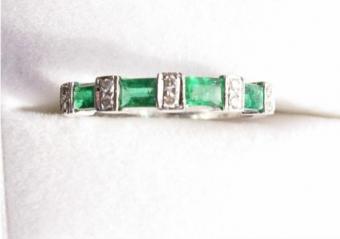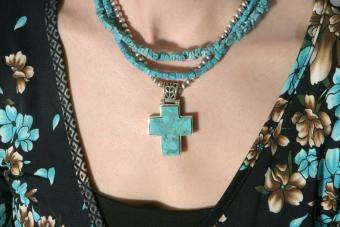
About Emerald Rings
Emerald rings are classy and sophisticated, and they transition smoothly from the office to an evening out. Whether or not you believe, as some do, that wearing an emerald ring brings you closer to nature, helps you to become wiser, or makes a woman's childbirth easier, it's easy to see why this rich green gem is associated with nature and thus fertility and how such beliefs could arise. Because of the association with nature and thus life, emeralds are often used in religious jewelry with a resurrection theme, such as crucifixes.
Cuts and Settings
Because of their natural structure, emeralds are typically cut in rectangles (the emerald cut), squares, or sometimes ovals. More of the original stone is usually wasted in round or pear shapes, unless the cutter is working around a flaw, so these cuts can cost more.
Emeralds are generally set in yellow gold because the two rich colors complement one another so well, but you can still find white gold or platinum settings. Given an intensely colored stone, this can be a very sleek and modern look, though the white can make a less vivid stone look lifeless.
Picking a Ring
The Stone
The most prized emerald color is a saturated, bright grass green with a hint of blue; these stones mostly come from Colombia. However, there are a wide range of other desirable colors, varying by how bright or dark they are, and whether the green is pure or leans towards either blue or yellow. The important thing is that you find the emerald that pleases you. Except for the most expensive stones, virtually all emeralds have visible flaws, including internal fractures. Even in ancient times, jewelers treated emeralds with oil to fill these fractures and significantly improve the color as well as overall appearance. Sometimes the fractures are filled with other material, such as colored epoxies. These are considered standard treatments though the jeweler should still disclose them.
The Setting
The ring setting should both show off and protect your stone. It's also fine if the setting conceals any flaws, as long as the jeweler tells you of their existence and doesn't pass off a flawed stone as being of higher quality than it is. The right setting can protect your ring; there shouldn't be any exposed corners, since these are particularly vulnerable places. Because of their internal flaws, emeralds are more vulnerable to breakage than softer but tougher stones. A setting with a closed back can make the color richer and also conceal flaws better than an open-backed setting. Again, this is not a problem as long as the jeweler informs you.
Taking Care of Your Ring
Emeralds are almost always oiled or given other treatments to fill miniature fractures in the stones, so they should not be washed in soapy water. Because of inclusions, emeralds should never be put into an ultrasonic cleaner. This can literally shatter them from the inside out. Also, you should never wear an emerald ring while doing dishes or any other activity where you might hit your hand against a hard surface, as this, too, could shatter a stone if you hit it at exactly the wrong angle. Cabochon stones are far less likely to be damaged by a blow although they are just as vulnerable to ultrasonic cleaning. That said, emeralds are still harder than many other common ring stones and the vast majority of owners don't experience any problems at all.







